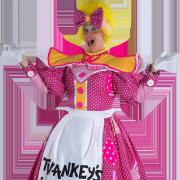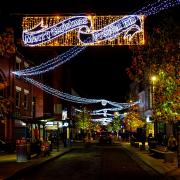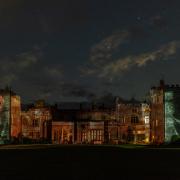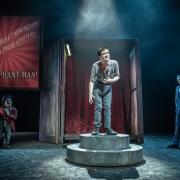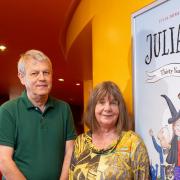Linda Viney joins fans of TV gardener Monty Don as he visits an ancient Lancashire garden

The red rose of Lancashire (Rosa Gallica Officinalis) will soon find a place in Longmeadow, the Herefordshire plot which stars alongside Monty Don in BBC TV’s Gardeners’ World.
The plant was presented to him by Maureen Little as a thank you for travelling to Stydd Gardens in Ribchester where he captivated and inspired the audience during an ‘Afternoon with Monty Don’.
Stydd Gardens provide a taste of English romanticism with a huge array of traditional scented roses, many remaining from the days it was a nursery which specialised in old fashion varieties. For the last 12 years the place has been owned by businessman Stephen Fullalove, who works alongside gardener Ken Walton restoring and embellishing the gardens. Maureen, known as the Bee Lady, runs the plant centre at Stydd and invited Monty to visit. No one was more surprised and delighted than Maureen when he agreed. Perhaps, the prospect of afternoon tea supplied by The Striped Pig at Garstang swung it.
Anyone who has watched Monty on television knows he is a passionate hands-on gardener and he began by asking us why we garden. His love affair started when, along with his brothers and sisters, his ‘hard taskmaster’ mother got the family weeding, mowing and turning compost. They are all gardeners now.

‘I once had a dream,’ he told us, ‘that my hands had grown roots which became rooted in the ground, looking to the soil for nourishment. That dream, together with a great deal of luck, has made me what I am today.’
He described gardens as places of privacy and must always be personal and individual. Be observant, he urged, and keep looking at it. ‘They are like rivers and keep moving all the time.’ Flowers should be picked every day, a small posy or a bouquet, so a piece of the garden could be taken indoors.
Monty has always been an organic gardener believing that by working with nature you can ensure the balance works. He said soil was the most important thing in any garden - it is the best tool and by feeling it in your hands you get a sense of being at one with nature. ‘Don’t challenge it, nourish it and grow what will do well,’ he said.
Although Monty has rarely ventured into Lancashire he vows to return and commented on the beautiful roses clambering over the Stydd dovecote. Even the doves were out to greet him.
After his talk he took time to answer questions and posed for selfies. ‘I felt privileged to have been invited and delighted to meet so many enthusiastic gardeners, in such a delightful place,’ he said as he left back to his home with the rose under his arm. Maureen has also discovered it was his birthday and a stunning cake was presented to him by Rose Pyle of the ‘Rosie Duck’ deli-cake business at Stydd.
Peaceful plot
Stydd Gardens are a welcoming, peaceful place and when the roses are in full bloom the fragrance fills the air. There are many single flowered specimens as they are especially attractive to bees providing easy access to their nectar. Maureen Little can’t stress enough the importance of growing flowers for the butterflies and bees.
Gardener Ken Walton said they worked hard to get the gardens looking great all year as they are only closed between Christmas and New Year (plus Mondays except for Bank Holidays). The gardens have many unusual roses like the ‘Browsholme’ rose and the ‘Rhodes’ rose which they are trying to propagate.
Stephen Fullalove bought the gardens in 2004 and has added summerhouse-style buildings for individual businesses, including Maureen’s which is devoted to all things connected with bees. There is a restaurant situated in the old glasshouse, a wine specialist, cafe as well as gifts and a spa.
Rose by any other name
No one is certain which variety of rose was first used as the symbol of Lancashire but most agree it is probably Rosa Gallica Officinalis. Also known as Apothecary’s Rose, Old Red Damask and Rose of Provins, it may be the first cultivated rose. It was discovered by the ancient Persians and Egyptians and was adopted by the Romans, who introduced it to Gaul where it derives its name. It is documented that Charlemagne’s court used it as a perfume and it was also in many medicinal remedies. It became the emblem of Lancashire following the Battle of Bosworth in 1485, then combined with the Yorkshire emblem to become the Tudor rose.












